
Seat Arona Review

Introduction
Seat is a brand that aims to inject a bit of sportiness into its range, but can it do that with a small SUV? The Arona suggests that yes, it can. In a packed market of stylish, practical and clever cars, the Arona stands out as one of the most enjoyable to drive, without compromising the attributes that attract small SUV buyers in the first place. It’s still stylish, affordable and practical, but get it on a country road and it’ll put a larger smile on your face than most of its competitors. If that sounds like a recipe you want to taste, then this could be the small SUV for you.
Select's rating score* - 3.7 / 5
At a Glance
If you’ve been looking at new cars over recent years, you’ll have noticed an awful lot of small SUVs on the market. It’s one of the fastest growing segments in the automotive world, with buyers lured in by the promise of practicality, style and a lofty, commanding driving position, all with the footprint of a regular hatchback.
The trouble is, small SUVs are rarely much fun to drive, and for some, that’s a problem. But Seat’s Arona aims to tackle that. The Spanish brand has a history of nippy, fun machines, including the very enjoyable larger SUV, the Seat Ateca. So has it managed to distill that mix of SUV appeal and sporty handling into a smaller package?
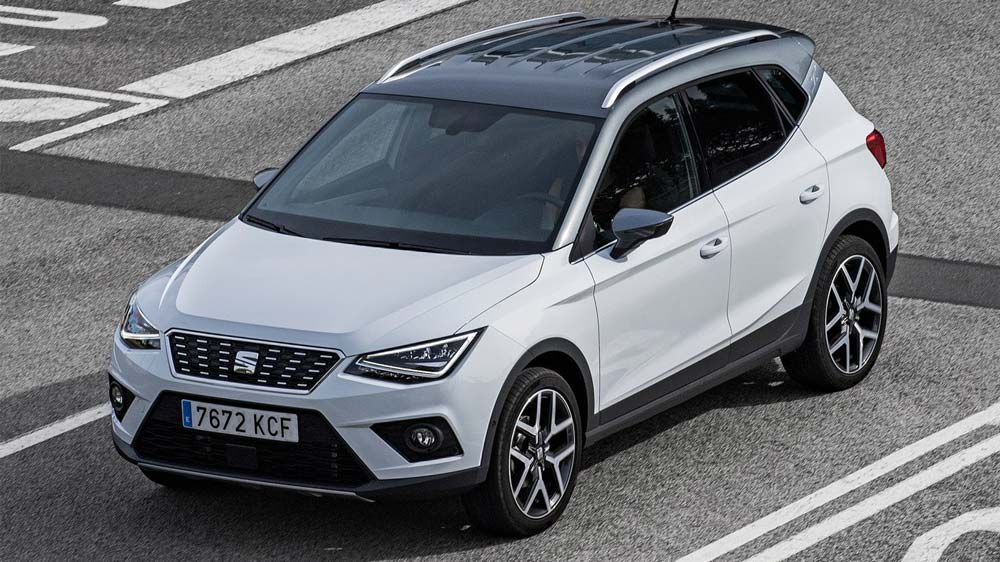
The Arona first appeared in 2017 and launched into a marketplace already packed with small SUV rivals, many of which are very decent. This meant that Seat had its work cut out to tempt customers away from the likes of the Kia Stonic, Nissan Juke, Renault Captur and Peugeot 2008, but it hit the ground running with a very decent machine.
To hedge its bets a little, Seat has divided the Arona range into the sporty and the slightly less sporty, just in case some customers still want a comfort focus. So when you look through the trim range, know that models with FR in the name will have a bit more zing to the handling by way of a sportier suspension set up.
While a diesel version of the Arona was available when it first launched, the public appetite for diesel has dropped considerably of late, and you can now get the Arona only in petrol form. But there are three engines to choose from, and both manual and automatic gearboxes.
Key Features
FR models of the Arona have a sportier vibe to them, and that’s not just confined to the looks. The suspension on these cars has been tuned for sharper handling, while other trim levels, from the entry-level SE to the top-spec Xcellence Lux, have a more comfort focused set up. FR models also get sportier seats, tinted windows and a flat-bottomed steering wheel (like a racing car), while the top-spec non-FR models are loaded with comfort features like ambient interior lighting, adaptive cruise control and keyless entry and start.
That said, all models are pretty well kitted out, with alloy wheels as standard, LED daytime running lights for a modern look, DAB radio and a colour touchscreen infotainment system with Apple CarPlay and Android Auto, so you can hook up your smartphone and control apps from the car screen. You’ll also get air conditioning on every model too.
Performance & Drive
The Arona is available with a choice of three petrol engines. The first is a turbocharged 1.0-litre with 94bhp. That might sound quite small, but it’s actually pretty peppy and if you mostly drive around town, it could well be sufficient for your needs. It comes with a five-speed manual gearbox, but is only available with the two lowest trim levels.
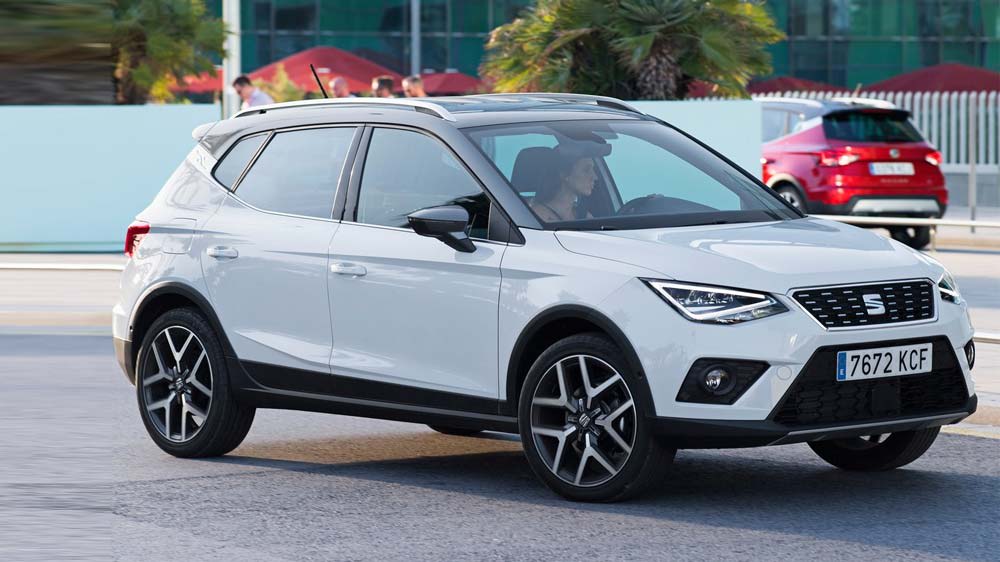
If you want more punch, then the 1.0-litre engine is available with 114bhp and a six-speed manual gearbox, and that extra power and extra gear makes it much more flexible for faster driving. If you do regular motorway journeys, or often have passengers in the car, then this is likely to be a better option. You can also get this engine with a seven-speed automatic gearbox.
For considerably more zing, there’s a 1.5-litre engine with 148bhp, available only with the seven-speed automatic gearbox and only in the sporty FR trims. It’s got much more oomph than the other two engines, so if you’re after the sportiest experience possible from your Arona then this should be one to check out.
Non-FR models come with standard, comfort focused suspension, which strikes a decent balance between ride comfort and composure through the corners. It’s still a Seat, so there’s still an element of zippiness to proceedings, courtesy of quick-feeling steering, but the weight of the steering wheel is light enough to allow easy manoeuvring around town.
The FR models feel noticeably sharper and more agile, but impressively they still ride very nicely. You’ll be aware of what kind of road surface is underneath you, but you won’t have your fillings shaken out on rougher tarmac. If comfort is your absolute priority then have a look at Citroen’s C3 Aircross before you pick the Arona, but the Seat is still more than acceptable.
Running Costs
If you’re someone that does high mileage, you may miss the fuel economy that a diesel-powered rival can offer, but that said, the small-yet-punchy petrol engines in the Arona are pretty good when it comes to fuel consumption.
As you might expect, the less powerful engines will give you a slightly better economy. The 94bhp 1.0-litre unit will give you between 47.1 and 51.4mpg according to official figures, and that drops a bit to between 42.5 and 49.6mpg in the 114bhp version. That’s with the manual gearbox; if you opt for the automatic, you’ll see a very small drop in fuel economy, to 42.8-47.9mpg. Impressively, the 1.5-litre engine isn’t actually that far behind the smaller units, with an official fuel economy range of between 42.2mpg and 45.6mpg.
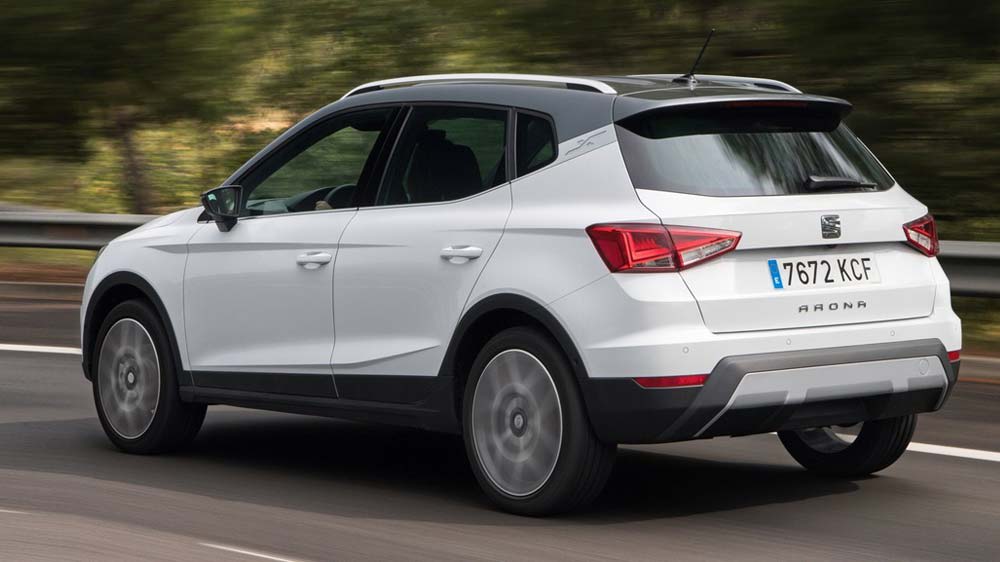
The Arona also tends to have good resale value, which translates to competitive leasing rates. Servicing costs aren’t particularly high either, which means overall running costs compared with most rivals will be rather attractive.
Should you be particularly worried about carbon dioxide emissions then you’ll find that the 94bhp, 1.0-litre engine emits fewer of them than the other models, with an official figure of 124g/km. If you’re a company car driver, that puts it in the 27% bracket for Benefit in Kind tax (2020/2021), but keep in mind that those brackets rise by 1% each year.
Cars with the 1.0-litre 114bhp engine and a manual gearbox emit between 130 and 135g/km of CO2, depending on trim. That means most sit in the 29% tax bracket, but the top-spec Xcellence Lux trim sneaks into the 30% bracket.
Opting for an automatic gearbox will have a small effect on CO2 emissions. The 114bhp 1.0-litre engine will emit either 134g/km or 137g/km, with the FR Sport and Xcellence Lux models tipping over from the 29% tax bracket into 30%.
If you go for a sporty 148bhp, 1.5-litre engine, you’ll have emissions of 140g/km in the FR model and 143g/km in the FR Sport model, both of which will sit in the 31% tax bracket.
Interior
Seat is part of the Volkswagen Group, which means it shares quite a lot of components with other brands like VW and Skoda, and that includes the interior. That’s not a bad thing at all, as the quality of materials and the way they’re put together tends to be rather good.
The Arona is no exception. Some might say it’s not as adventurous in design as Citroen’s C3 Aircross or the Renault Captur – and they’d have a point – but everything’s laid out in a logical and easy-to-find format, and all models get an intuitive touchscreen infotainment system in the centre of the dashboard. The screen is 6.5 inches in size in the entry level SE model, but all the other trims get a larger 8.0-inch screen and extra systems within.
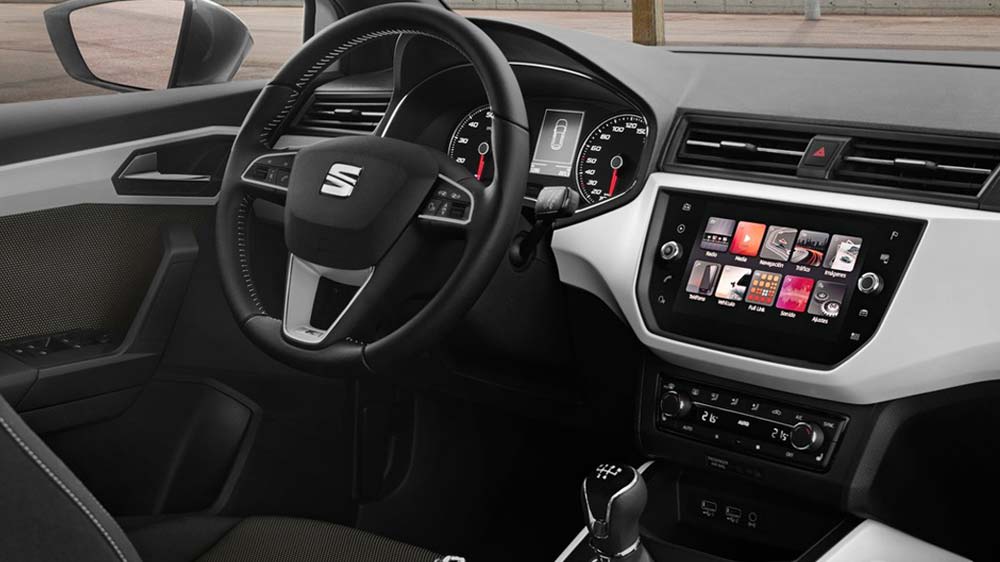
FR models get more supportive sports seats, and top-spec Xcellence cars get extra storage spaces inside. The FR Sport and top-of-the-range Xcellence Lux have a fancy digital instrument panel behind the steering wheel, rather than regular analogue dials.
At this end of the market, most of the clever tech you’ll find is within the entertainment system. All Aronas have one, although it’s a bit less sophisticated in the entry-level SE model, which has a 6.5-inch touchscreen. That said, it still comes with Bluetooth and hands-free phone setup, DAB radio and smartphone integration through Apple CarPlay and Android Auto. It doesn’t get satellite navigation, but with plenty of navigation apps available on smartphones, you could fire one of those up and display it on the car’s screen very easily.
If you do want in-built navigation though, all other models from SE Technology and up have it as standard, displayed on a bigger 8.0-inch touchscreen. The interface is very easy to use and quick to respond, and features a clever proximity centre that knows when your hand is approaching the screen and displays extra buttons, which then disappear again when you remove your hand, leaving a cleaner-looking display.
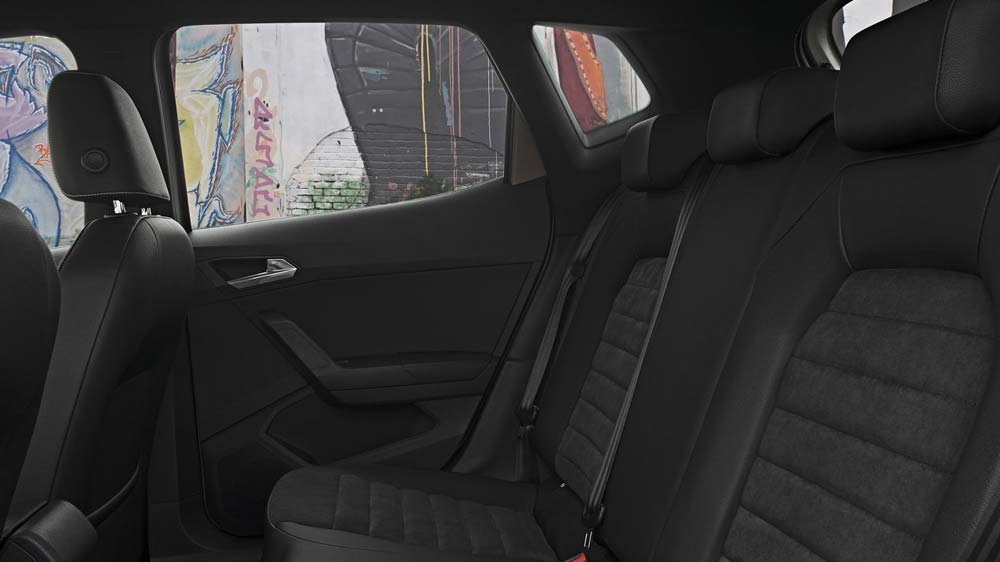
As well as the bigger infotainment screen, you’ll also get a wireless phone charging pad in front of the gearstick, and a USB charging point, although note that it’s the newer USB-C port, which could require an adapter for older devices.
Other tech of note includes the Digital Cockpit, which is a digital instrument panel; a screen behind the steering wheel in place of traditional analogue dials. This comes on the FR Sport and Xcellence Lux models, and means you can switch between different information displays depending on what driving details you want to see.
The Xcellence and Xcellence Lux models get adaptive cruise control, which lets you set a speed on the motorway and the car will hold it, but if there’s a slower vehicle in front, the Arona will automatically slow down, match the speed of the slower vehicle and keep a safe gap between the vehicles. This can take a lot of stress out of traffic-filled journeys.
Practicality & Boot Space
The Arona is not a big car, but it maximises its interior space very well. Four adults will have no issues getting in, but three in the back will be a bit of a squeeze, and you may find a bit more space in the back of the Citroen C3 Aircross, Volkswagen T-Cross or a Skoda Kamiq. But the Arona is still impressive, with lots of places to keep bits and bobs around the cabin. Xcellence models get an extra storage pack, which includes a drawer under the passenger seat and a rack under the driver’s seat, as well as storage pockets in the back of the front seats.
If you need flexibility in the boot space, then there are other cars that do a bit better. The Arona doesn’t have the sliding rear seats of Renault’s Captur, the MIni Countryman or the VW T-Cross, but at 400 litres the boot is sizeable, and bigger than the Kia Stonic and Hyundai Kona. It’s not quite as big as the Skoda Kamiq or Renault Captur though. You can fold the rear seats down if you need extra space, and a movable boot floor means you can make the load space completely flat, which can be very useful.
Safety
The Arona was tested by safety organisation Euro NCAP in 2017 and scored the maximum five stars, with a particularly high score for adult occupant safety. It scored well for child occupant safety and pedestrian safety as well, but some rivals have scored better for their safety assist systems.
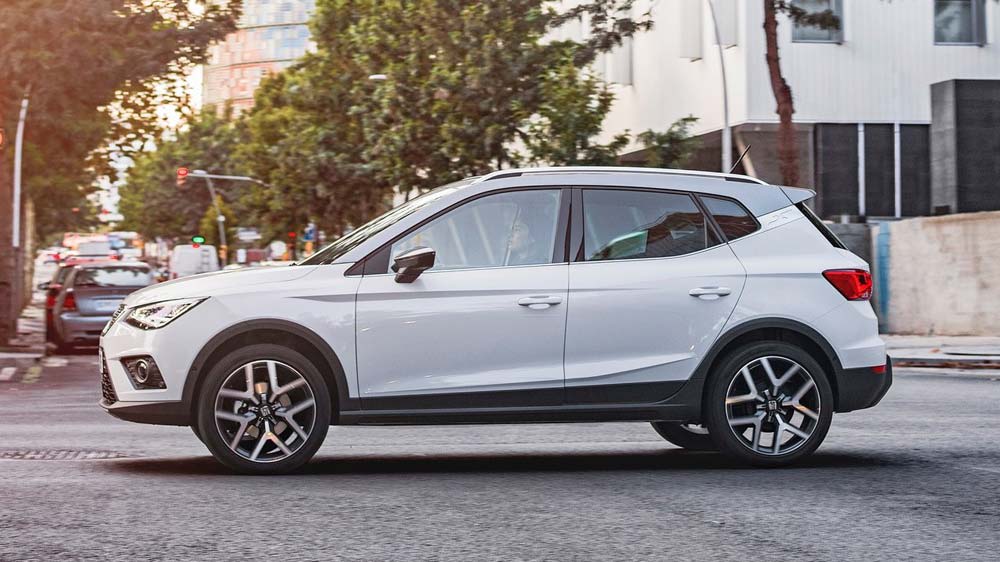
Every Arona comes with automatic emergency braking, which will intervene if you don’t respond to an impending accident, and a tiredness recognition system, which will warn you if you’re at risk of dropping off behind the wheel. You’ll also get Isofix child seat mounting points on the outer rear seats, and front, side and curtain airbags. Xcellence and Xcellence Lux models get a blind spot monitoring system too.
Options
There’s a good spread of models in the Arona range, which should mean there’s one to suit your requirements and budget. The range starts with the SE, which rides on 17-inch alloy wheels and includes the entry-level infotainment system, while the SE Technology gets the upgraded infotainment system and rear parking sensors.
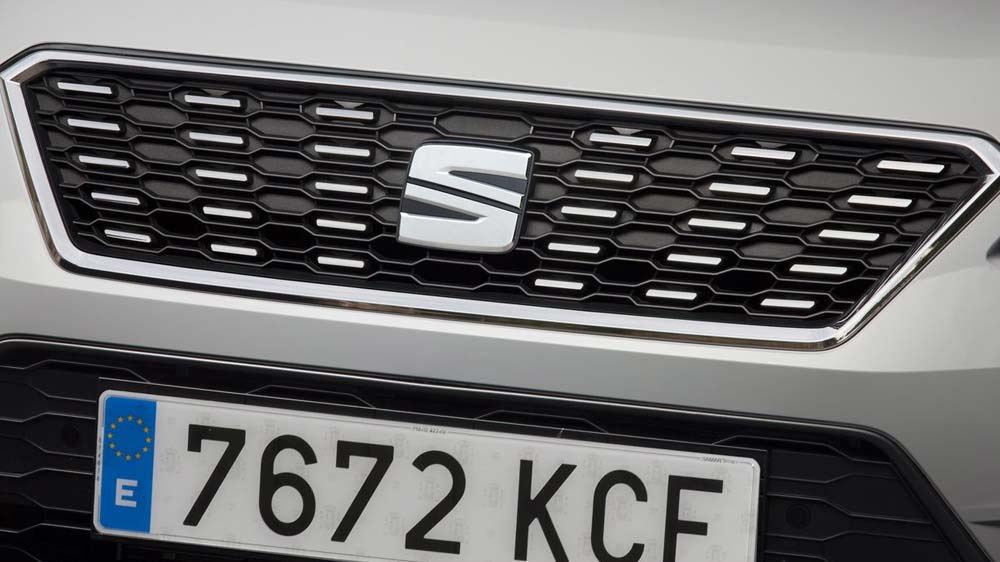
The sporty FR model has tinted rear windows, a chrome front grille and the door mirrors are heated and fold when you lock the car. There are chrome roof rails and window surrounds, and the full LED headlights are upgraded from the SE cars. Inside, you’ll get the more supportive sports seats, a different steering wheel with shifter paddles on the automatic gearbox cars, and a plusher-looking leatherette finish on the dashboard. The air-conditioning is upgraded to a dual-zone system. The FR Sport adds bigger 18-inch alloy wheels and a suede-like upholstery, and the front seats are heated for those cold winter mornings.
The Xcellence model rides on 17-inch alloy wheels, machined to differentiate the finish from lower models, and also features adaptive cruise control, keyless entry and start and a white dashboard. Xcellence Lux rides on 18-inch wheels and also gets the suede-like upholstery, as well as a rear-view camera and front parking sensors.
Options are relatively few, with Seat deciding to keep things simple for customers. But you can choose between a variety of metallic or non-metallic paint colours, and you can have a contrasting roof colour in grey or black too. That’s it.
Who Rivals The Seat Arona?
The small SUV market is a very busy one, and there are lots of rivals for the Seat Arona, of which many are also worth checking out.
It makes sense to start with its sister cars from the Volkswagen Group, namely the Volkswagen T-Cross and the Skoda Kamiq. Both of these offer a bit more space, but aren’t as involving to drive and, arguably, aren’t as stylish. However, they do offer a very good benchmark in most areas.
If style is your bag then the quirky Citroen C3 Aircross should be on your list, as should the Peugeot 2008, the DS 3 Crossback and the visually divisive Nissan Juke. When it comes to value for money, the Kia Stonic is worth checking out, although it’s smaller than the Arona, and Dacia’s Duster represents a lot of car for the money.
Should the sporty handling of the Arona appeal, make sure you look at Mazda’s CX-3, as it’s just as good, if not better than the Seat when it comes to smiles-per-hour, although it’s not as spacious inside.
Renault’s Captur is a key rival as well, and is available as a diesel if you want one, and Ford’s Puma can be specced with a mild-hybrid system to help save a bit of fuel.
For a bit of extra premium appeal, check out the Audi Q2 or the Mini Countryman, but expect to pay more for the badge
Verdict & Next Steps
The Seat Arona offers customers a compact family SUV with the space and features that you’d expect, but with some extra pizazz to the driving experience. It’s a car to put a smile on your face, but will also do the school run and shopping trip without fuss or complaint. Impressive standard equipment and a range of engines and trim levels mean lots of choice across different budgets, and it looks good too. In a packed market of small SUVs and crossovers, this is well up with its rivals and should, at the very least, be on your list of cars to check out.
Where to next?
- View latest SEAT Arona car leasing deals - available from just £184.79 per month**
- Looking for a great deal? Check out our incredible range of car lease deals
- New compact SUV for the family? Read our latest Car Reviews including our Ford Puma Review or Volvo XC40 Review
- Want to know more about leasing? Take a look at our comprehensive Leasing Guides
- Interested in everything motoring? Why not catch up on all the latest Car Leasing News.
*Score based on Select’s unique meta score analysis, taking into account the UK’s top six leading independent car website reviews of the Seat Arona
**Correct as of 28/10/2020. Based on 9 months initial payment, 5,000 miles over a 48 month lease. Initial payment equivalent to 9 monthly payments or £1,633.09 Ts and Cs apply. Credit is subject to status.

.jpg)
.jpg)
.jpg)















